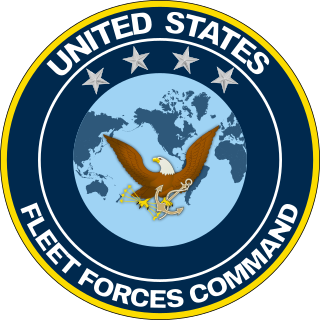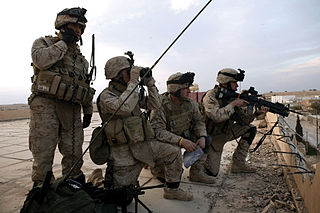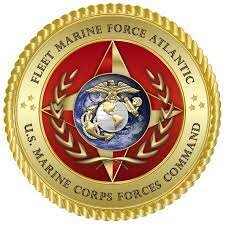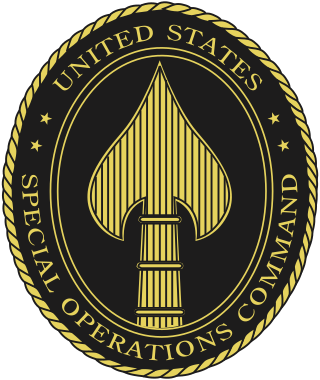History
The command was activated on 1 October 2020. The commander of MARFORSPACE is dual-hatted as the commander of Marine Corps Forces Cyberspace Command, though the two organizations are separate commands with their own structure. Many members of MARFORSPACE were formerly part of Marine Corps Forces Strategic Command (MARFORSTRAT). The purpose of Marine Forces Space Command is to provide space operational support and capabilities to the Fleet Marine Force. [1] [2] The first Marine personnel of MARFORSPACE received training from the 1st Space Brigade of the United States Army Space and Missile Defense Command. [3]
Although the Marine Corps does not operate any spacecraft, the Marines also use the capabilities of these systems, and previously relied on the Army's 1st Space Brigade for planning and coordinating space support capabilities during operations in Iraq. The Marine Corps had its own space operations officers that were part of Marine Corps Forces Strategic Command (MARFORSTRAT), [4] who became part of MARFORSPACE upon its creation. [1]
In October 2021, the headquarters of MARFORSPACE relocated from Offut Air Force Base in Nebraska to the Peterson Space Force Base in Colorado. The Marine Space Support Team also conducted its first deployments that year, in support of U.S. European Command and the 31st Marine Expeditionary Unit. In 2022, a new MOS, 1706 – Maritime Space Officer, was created, with specialized training for the space domain. [5]
The United States Armed Forces are the military forces of the United States. The armed forces consist of six service branches: the Army, Marine Corps, Navy, Air Force, Space Force, and Coast Guard. All six armed services are among the eight uniformed services of the United States.

The United States Fleet Forces Command (USFF) is a service component command of the United States Navy that provides naval forces to a wide variety of U.S. forces. The naval resources may be allocated to Combatant Commanders such as United States Northern Command (USNORTHCOM) under the authority of the Secretary of Defense. Originally formed as United States Atlantic Fleet (USLANTFLT) in 1906, it has been an integral part of the defense of the United States of America since the early 20th century. In 2002, the Fleet comprised over 118,000 Navy and Marine Corps personnel serving on 186 ships and in 1,300 aircraft, with an area of responsibility ranging over most of the Atlantic Ocean from the North Pole to the South Pole, the Caribbean Sea, Gulf of Mexico, and the waters of the Pacific Ocean along the coasts of Central and South America.

The U.S. Military Assistance Command, Vietnam (MACV) was a joint-service command of the United States Department of Defense, composed of forces from the United States Army, United States Navy, and United States Air Force, as well as their respective special operations forces.

ISTAR stands for intelligence, surveillance, target acquisition, and reconnaissance. In its macroscopic sense, ISTAR is a practice that links several battlefield functions together to assist a combat force in employing its sensors and managing the information they gather.

The United States Space Command is a unified combatant command of the United States Department of Defense, responsible for military operations in outer space, specifically all operations 100 kilometers and greater above mean sea level. U.S. Space Command is responsible for the operational employment of space forces that are provided by the uniformed services of the Department of Defense.

The United States Army Space and Missile Defense Command (USASMDC) is the Army Service Component Command (ASCC) for United States Strategic Command and United States Space Command. It was established in 1985 as the Army Strategic Defense Command, responsible for ballistic missile defense. In 1992, it merged with Army Space Command to become Army Space and Strategic Defense Command. In 1997, it became an Army Major Command and was redesignated Army Space and Missile Defense Command.

The United Kingdom's Strategic Command (StratCom), previously known as Joint Forces Command (JFC), manages allocated joint capabilities from the three armed services.

Air Naval Gunfire Liaison Company (ANGLICO) is an airborne fire support and liaison unit of the United States Marine Corps. The mission of ANGLICO is "To provide Marine Air-Ground Task Force (MAGTF) Commanders a liaison capability to plan, coordinate, and conduct terminal control of fires in support of joint, allied, and coalition forces. Per this mission statement, ANGLICOs are not designed to support U.S. Marine Corps maneuver elements. Instead, the doctrinal purpose of ANGLICO is to provide fire support and coordination in support of units adjacent to the MAGTF.

The 11th Marine Expeditionary Unit is one of seven Marine Expeditionary Units currently in existence in the United States Marine Corps. The Marine Expeditionary Unit is a Marine Air Ground Task Force with a strength of about 2,200 personnel. The MEU consists of a command element, a reinforced infantry battalion, a composite helicopter squadron and a logistics combat element. The 11th MEU is currently based out of Marine Corps Base Camp Pendleton, California with headquarters in Camp Del Mar.

The United States Fleet Marine Forces (FMF) are combined general- and special-purpose forces within the United States Department of the Navy that perform offensive amphibious or expeditionary warfare and defensive maritime employment. The Fleet Marine Forces provide the National Command Authority (NCA) with a responsive force that can conduct operations in any spectrum of conflict around the globe.

The United States Marine Corps is organized within the Department of the Navy, which is led by the Secretary of the Navy (SECNAV). The most senior Marine commissioned officer is the Commandant of the Marine Corps, responsible for organizing, recruiting, training, and equipping the Marine Corps so that it is ready for operation under the command of the unified combatant commanders. The Marine Corps is organized into four principal subdivisions: Headquarters Marine Corps, the Operating Forces, the Supporting Establishment, and the Marine Forces Reserve.

Military organization (AE) or military organisation (BE) is the structuring of the armed forces of a state so as to offer such military capability as a national defense policy may require. Formal military organization tends to use hierarchical forms.
The structure of the United States Navy consists of four main bodies: the Office of the Secretary of the Navy, the Office of the Chief of Naval Operations, the operating forces, and the Shore Establishment.
The Fleet Marine Force, Pacific (FMFPAC) is the largest maritime landing force in the world. Its units are spread across the Pacific Ocean and reports to the United States Pacific Command. It is headquartered at MCB Camp H. M. Smith, HI and directs and commands all the subordinate elements of the Navy Expeditionary Strike Force and Marine Air-Ground Task Force components that follow under the 3rd, 5th, and 7th Fleet and the Marine Corps Forces, Pacific (MARFORPAC). The Commanding General of Marine Corps Forces, Pacific is dual-posted as the Commanding General of Fleet Marine Force, Pacific. FMFPAC is under operational control of the Commander, United States Pacific Fleet (COMPACFLT), when deployed.

The Fleet Marine Force, Atlantic (FMFLANT) is an American maritime landing force that is spread across the Atlantic Ocean. It is headquartered at Naval Station Norfolk and directs and commands all the subordinate elements of the Navy Expeditionary Strike Force and Marine Air-Ground Task Force components that follow under the 2nd, 4th, and 6th Fleet and the Marine Forces Command (MarForCom). The Commanding General of Marine Forces Command is dual-posted as the Commanding General of the Fleet Marine Force, Atlantic. FMFLANT is under operational control of the Commander-in-Chief, United States Fleet Forces Command, when deployed.
The United States Marine Corps is tasked by Department of Defense directive to "conduct complex expeditionary operations in the urban littorals and other challenging environments" and "conduct amphibious operations, including engagement, crisis response, and power projection operations to assure access." Before 2006, the Marine Corps was the only branch of the Armed Forces that did not have any of its special warfare elements participating in the United States Special Operations Command (USSOCOM), due to confining its special operations capabilities only for the purpose to the Fleet Marine Force.

The United States Special Operations Command is the unified combatant command charged with overseeing the various special operations component commands of the Army, Marine Corps, Navy, and Air Force of the United States Armed Forces. The command is part of the Department of Defense and is the only unified combatant command created by an Act of Congress. USSOCOM is headquartered at MacDill Air Force Base in Tampa, Florida.

The United States Space Force is organized by different units: the Space Staff, the field commands, and the space deltas.
United States Marine Corps Forces Strategic Command is the Marine Corps service component of U.S. Strategic Command. MARFORSTRAT is responsible for representing Marine Corps interests and advising the Commander, U.S. Strategic Command, on supporting Marine Forces, as well as assisting other Marine Corps commands with the usage and development of electronic warfare, and ensuring the integration of Strategic Command and the Marine Corps. It is based at the headquarters of Strategic Command at Offutt Air Force Base in Nebraska.


















